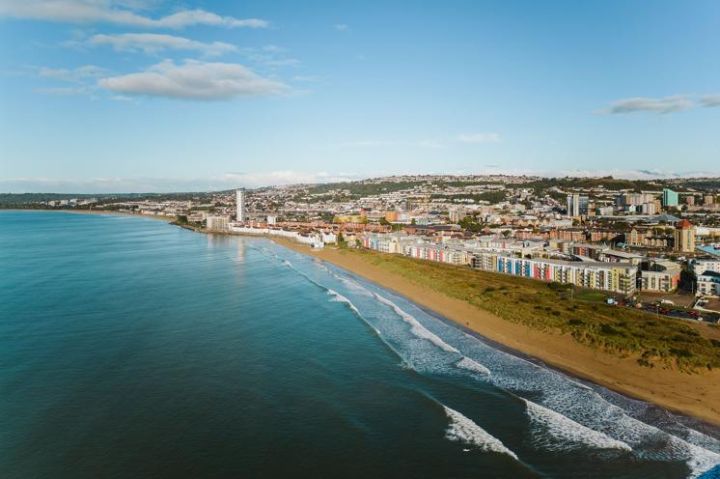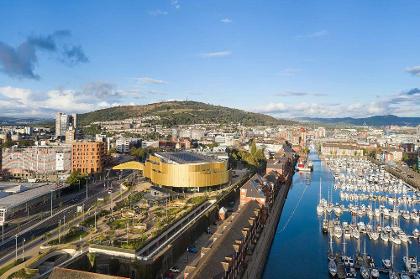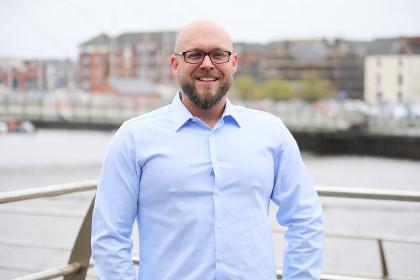The dictionary definition of regeneration is “the regrowth of lost or destroyed parts or organs, or spiritual or moral revival or rebirth.”
In terms of Swansea, the transformation of its civic and historic buildings as well as the commercial infrastructure is both. The physical reconstruction is redefining the architectural look and aspect of the city, but the results are developing cultural revival and a positive growing energy which reaches into the surrounding region and beyond.

Parc Felindre itself is an example of successful regeneration. A disused and tin plate works was decommissioned in 1989 and has been transformed into quality high value business land, developed as a Strategic Business Park through a Joint Venture between Swansea Council and the Welsh Government.The redesigned landscape of Parc Felindre’s business land is available and ready for other industries to join the high calibre business in the region.

The region hosts a modern service sector economy, a mature base for IT, Software Development, Digital and Multimedia companies and is home to a wide range of national and international companies. Neighbouring universities and colleges also offer a technically skilled and well educated workforce, experienced in specialist industries such as Health, Precision Engineering, Aerospace, Emergent Technologies, Computer and Life Sciences.1
Regeneration Projects
From state-of-the-art office and leisure developments to plans for the UK's first tidal lagoon, Swansea is undergoing the most exciting transformation in the city's rich history.
Swansea Council, alongside public sector partners, is a proactive developer and/or funder of the key projects. These projects provide numerous regeneration benefits but significantly, they are also already acting as a catalyst for further development.
Building on the £1bn original regeneration granted by Margaret Thatcher’s government, the ongoing programme in the city is planned to make Swansea a premier destination to work, live, study, enjoy and visit.

For example, the £135m Copr Bay phase one scheme has been led by Swansea Council and supported by a range of partners including RivingtonHark.
It's made up of:
- the 3,500-capacity Swansea Arena, which is run by Ambassador Theatre Group (ATG) and part-funded by the Swansea Bay City Deal
- the new Copr Bay bridge over Oystermouth Road
- the 1.1-acre Amy Dillwyn Coastal Park
- a 33-apartment block being run by Pobl Group
- new car parking facilities on both sides of Oystermouth Road
Swansea Regeneration is a partnership working to maximise economic benefits from regeneration projects in order to improve the prosperity of the local area and its people.
It is made up of representatives from the private, public, education, voluntary and health sector and its terms of reference include:
- project development and troubleshooting role to help unlock delivery issues
- linking into employability programmes and Beyond Bricks and Mortar principles into regeneration activities
- intelligence gathering to inform local, regional and national economic regeneration plans
- promoting Swansea's economic regeneration agenda
- working with the Public Service Board (PSB) to take forward the City Deal and Infrastructure theme
- acting as the Local Stakeholder Project Board for the Welsh Government Transforming Towns Programme and UK Shared Prosperity Fund.2
Regeneration shows Swansea is 'serious about growth'
A Swansea business leader has praised the ongoing £1bn regeneration of the city centre.

James Smale-Davies, an associate director at RJ Chartered Surveyors, says
“the continuous investment shows Swansea is a city that's serious about growing its economy”.
"It's exciting to see such sustained commitment to building a city centre that's fit for the future. "This is a strong signal that Swansea is serious about growth, resilience, and making its city core a place where people genuinely want to work, live and invest."
The regeneration developed by Swansea Council includes Swansea Arena, the 71/72 Kingsway development and the new office building set for construction at the former St David's Shopping Centre site.
Those led by the private sector include the Princess Quarter office project, the biophilic building project, the Kings Building scheme on Kingsway Circle and the Market Lofts development.
Beacon Cymru is leading on plans for community projects to bring the former Castle Cinema building back into use, following on from the reopening of the Palace Theatre building and the Albert Hall.
Swansea Council is also leading the construction of the new office scheme planned for the former St David's Shopping Centre site, due to start in early 2026. The five-storey building will be part of a larger mixed-use development at the site led by Swansea Council in partnership with Urban Splash.
Mr Smale-Davies said: "It's great to see this new office development now edging closer to delivery because it's set to play a significant role in reinvigorating city centre footfall and supporting local businesses.”3
Transforming the face of the city, the bay and the region beyond is growing the advantage of a business sited at Parc Felindre. Visit our site plan now to see the available plots for your business https://parcfelindre.co.uk/en/site-plan.
References
1 https://parcfelindre.co.uk/en/about/the-ideal-location
2 https://www.swansea.gov.uk/article/27769/Regeneration-projects
3 https://swansea.gov.uk/article/39127/Regeneration-shows-Swansea-is-serious-about-growth?lang=en
Photographs courtesy of Swansea Council




